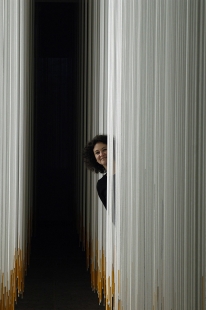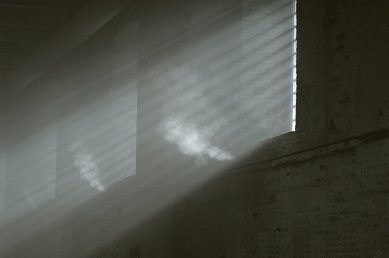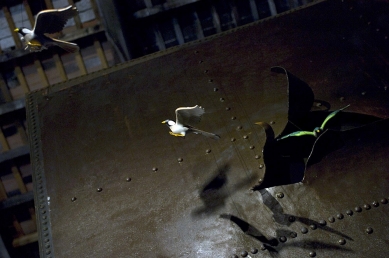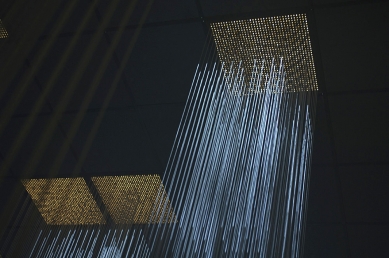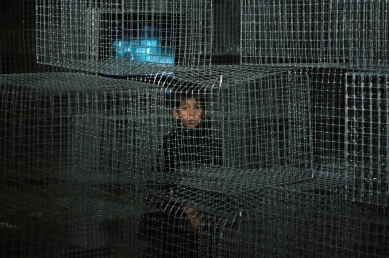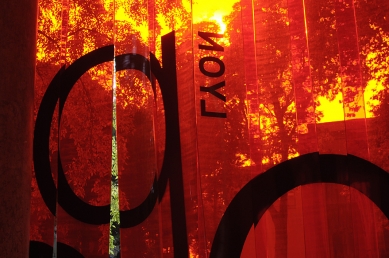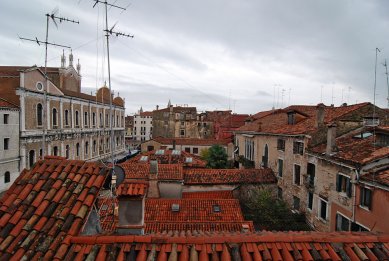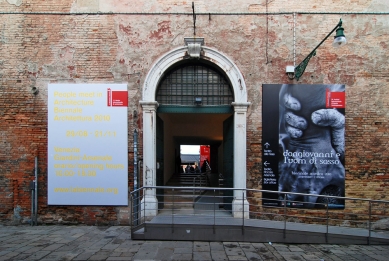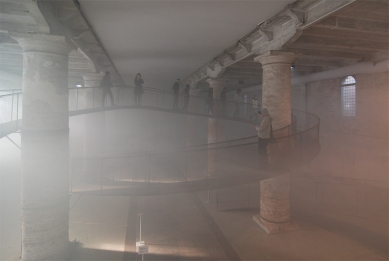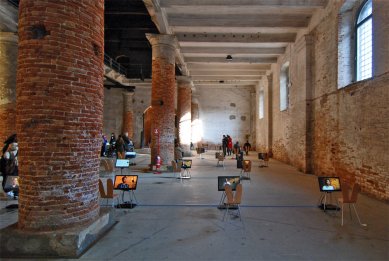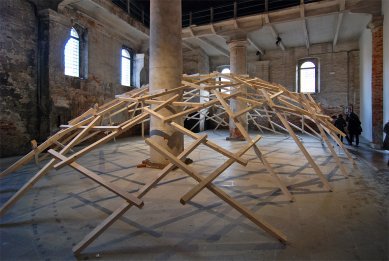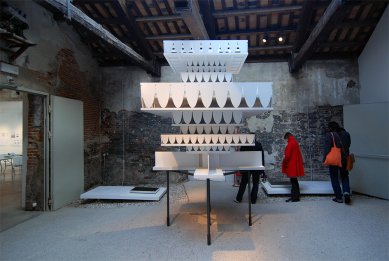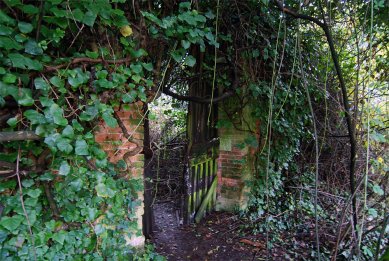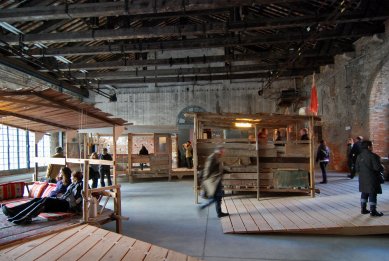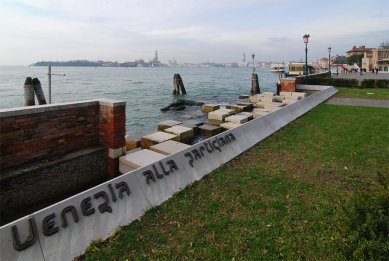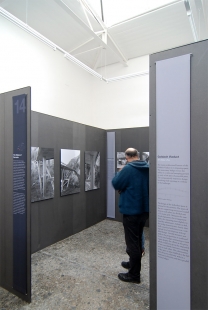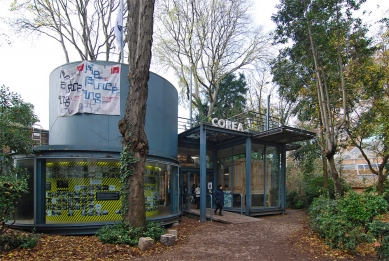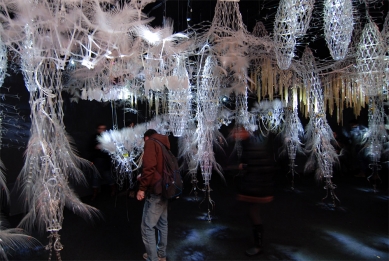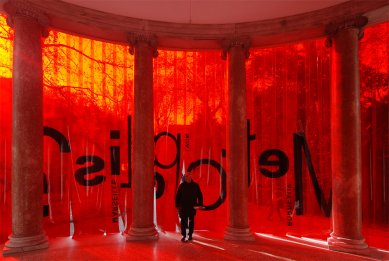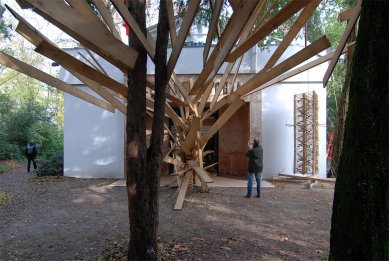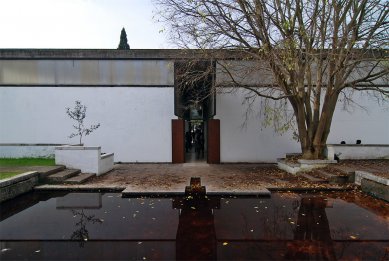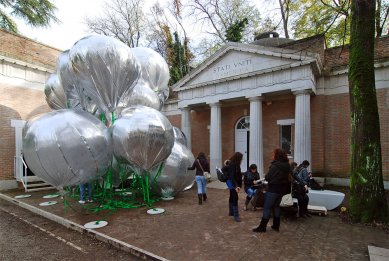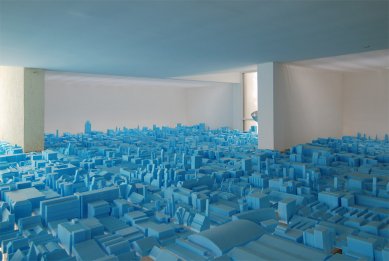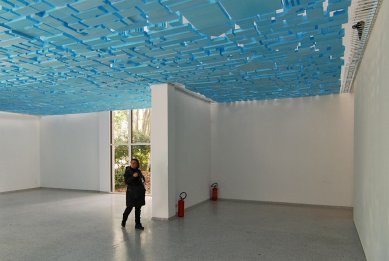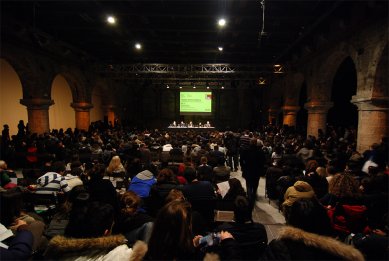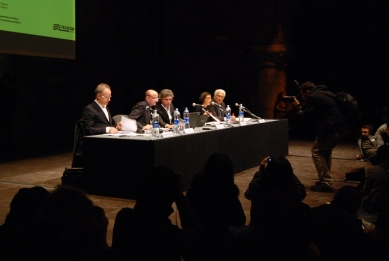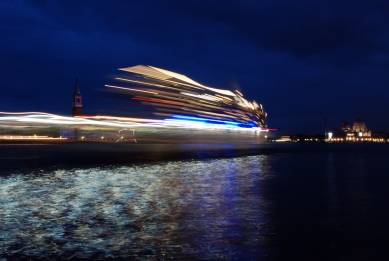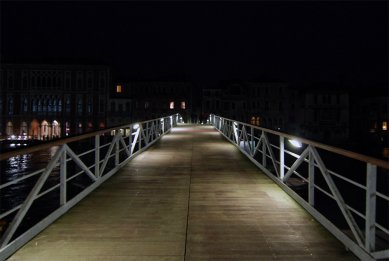
12. Biennale in Venice

Before and After
This year, we had the opportunity to experience the atmosphere of the Venice Biennale twice, each time in a completely different situation. First, we traveled to Venice in mid-August during the frenzied preparations and then in the last days before the conclusion of the three-month festival of architecture. The face of Venice remains unchanged, yet it manages to offer new strong experiences with every visit. This time, besides the flooded streets, it was primarily the Festa della Salute, celebrated annually on November 21, when a temporary bridge of boats is built in honor of the Virgin Mary's intervention against the plague in 1630, spanning between St. Mark's Square and the Santa Maria della Salute church. The last opportunity to visit this year's Biennale resulted in most hotels being fully booked, and even contacts from friends at mostly unusual accommodations did not help. In the end, we managed to secure a pleasant family accommodation with a view of the Church of St. John and Paul in an area that has not yet been completely taken over by the oppressive tourist atmosphere. During the first evening, we quickly realized how difficult it is to be served by an Italian in a restaurant due to globalization.
Walking through the almost deserted exhibition grounds before the gates opened to the public is as unusual as visiting the Biennale in the last days, when everyone is trying to catch up on what they have constantly postponed and failed to complete over the past three months. The pressing crowds perfectly fulfilled the motto of this year's Biennale 'Gathering People in Architecture.' Thanks to one such impromptu meeting with friends who one does not see throughout the year in the Czech Republic, we learned about a lecture planned at the Teatro Piccolo Arsenale, where the last lecture from the eight-part series of Architectural Saturdays took place. Besides the curator of this year's Biennale Kazuyo Sejima, the Spanish architect Antòn Garcìa-Abril, the Swiss architect Christian Kerez, director of international projects at London's Serpentine Gallery Hans Ulrich Obrist, and president of the Venice Biennale Paolo Baratta also spoke on November 20 at 2 PM. Baratta concluded by boasting about a record number of over 170,000 visitors (the event also lasted two weeks longer than the previous exhibition), but then, typically for an Italian, undermined his own project with the argument that the exhibited projects are not that important since most of the works could already be found in publications and at other exhibitions, but what is irreplaceable is the regular gathering of friends and getting to know new people.
The awarding of the Golden Lions followed a template where old acquaintances met on the lagoon and shared the awards. The curator of the 12th Biennale Kazuyo Sejima presented the Golden Lion for lifetime achievement to Rem Koolhaas and Kazuo Shinohara, the best national pavilion award went to the Kingdom of Bahrain, and the best project of the main exhibition became the web-like installation by Junya Ishigami, while the Silver Lion for promising young architects was awarded to the Belgian OFFICE Kersten Geers David van Severen. However, Ishigami's experiment met a similar fate as the floating Croatian pavilion, which had to be closed after half an hour, as this fragile steel structure completely collapsed during the Biennale. Ishigami's thin project 'Architecture as Air' was first damaged during construction by a cat, and then on the very first day when the Arsenale was open only to journalists, it was completely ruined by a cleaner who simply overlooked the installation. Similarly interesting stories, albeit not with such dramatic endings, could be found in most projects and national pavilions.
An urgent message was contained in the exhibition of the Kingdom of Bahrain, which presented itself at the Biennale for the very first time and immediately received the Golden Lion for national exposition. This small state in the Persian Gulf brought to one of the rooms in the Arsenale only three fishing huts and several testimonies (this endeavor was allocated 260,000 Euro), highlighting the country’s history, which lived for generations (until the discovery of oil reserves) from the gifts of the sea and how today's construction boom is increasingly cutting residents off from the sea. Ninety percent of this small state consists of desert, and significant financial resources are flowing into strengthening the coastline and expanding into the sea, making the original fishermen land dwellers, while new developers, with the help of SOM, create futuristic visions where access to the sea is perfectly obstructed by glass palaces.
I left with a warm feeling from the Czech-Slovak Pavilion. After many years, I could finally proudly identify with our exposition. Foreign visitors might not grasp Rajniš's story in all its complexity, but it was pleasant to see a large turnout and so many satisfied faces. From neighboring countries, perhaps only Canada (robotic plants from another planet), Japan (they had larger models), Switzerland (a long-prepared tribute to engineering structures), or the Netherlands (the potential of unused buildings) could have outdone the Czech-Slovak installation.
The theme of the previous Biennale was Architecture beyond Building, but only now have participants managed to go beyond ordinary construction and touch upon our other senses. I see the greatest benefit of the Biennale in the fact that people with hectic lifestyles find the time, agree, and go for a few days to Venice, where they must leave their car and daily hustle behind on the mainland. One can then pleasantly slow down, taste exquisite cuisine, and as a bonus, explore the best selection of contemporary architecture, which I will not miss even in two years.
This year, we had the opportunity to experience the atmosphere of the Venice Biennale twice, each time in a completely different situation. First, we traveled to Venice in mid-August during the frenzied preparations and then in the last days before the conclusion of the three-month festival of architecture. The face of Venice remains unchanged, yet it manages to offer new strong experiences with every visit. This time, besides the flooded streets, it was primarily the Festa della Salute, celebrated annually on November 21, when a temporary bridge of boats is built in honor of the Virgin Mary's intervention against the plague in 1630, spanning between St. Mark's Square and the Santa Maria della Salute church. The last opportunity to visit this year's Biennale resulted in most hotels being fully booked, and even contacts from friends at mostly unusual accommodations did not help. In the end, we managed to secure a pleasant family accommodation with a view of the Church of St. John and Paul in an area that has not yet been completely taken over by the oppressive tourist atmosphere. During the first evening, we quickly realized how difficult it is to be served by an Italian in a restaurant due to globalization.
Walking through the almost deserted exhibition grounds before the gates opened to the public is as unusual as visiting the Biennale in the last days, when everyone is trying to catch up on what they have constantly postponed and failed to complete over the past three months. The pressing crowds perfectly fulfilled the motto of this year's Biennale 'Gathering People in Architecture.' Thanks to one such impromptu meeting with friends who one does not see throughout the year in the Czech Republic, we learned about a lecture planned at the Teatro Piccolo Arsenale, where the last lecture from the eight-part series of Architectural Saturdays took place. Besides the curator of this year's Biennale Kazuyo Sejima, the Spanish architect Antòn Garcìa-Abril, the Swiss architect Christian Kerez, director of international projects at London's Serpentine Gallery Hans Ulrich Obrist, and president of the Venice Biennale Paolo Baratta also spoke on November 20 at 2 PM. Baratta concluded by boasting about a record number of over 170,000 visitors (the event also lasted two weeks longer than the previous exhibition), but then, typically for an Italian, undermined his own project with the argument that the exhibited projects are not that important since most of the works could already be found in publications and at other exhibitions, but what is irreplaceable is the regular gathering of friends and getting to know new people.
The awarding of the Golden Lions followed a template where old acquaintances met on the lagoon and shared the awards. The curator of the 12th Biennale Kazuyo Sejima presented the Golden Lion for lifetime achievement to Rem Koolhaas and Kazuo Shinohara, the best national pavilion award went to the Kingdom of Bahrain, and the best project of the main exhibition became the web-like installation by Junya Ishigami, while the Silver Lion for promising young architects was awarded to the Belgian OFFICE Kersten Geers David van Severen. However, Ishigami's experiment met a similar fate as the floating Croatian pavilion, which had to be closed after half an hour, as this fragile steel structure completely collapsed during the Biennale. Ishigami's thin project 'Architecture as Air' was first damaged during construction by a cat, and then on the very first day when the Arsenale was open only to journalists, it was completely ruined by a cleaner who simply overlooked the installation. Similarly interesting stories, albeit not with such dramatic endings, could be found in most projects and national pavilions.
An urgent message was contained in the exhibition of the Kingdom of Bahrain, which presented itself at the Biennale for the very first time and immediately received the Golden Lion for national exposition. This small state in the Persian Gulf brought to one of the rooms in the Arsenale only three fishing huts and several testimonies (this endeavor was allocated 260,000 Euro), highlighting the country’s history, which lived for generations (until the discovery of oil reserves) from the gifts of the sea and how today's construction boom is increasingly cutting residents off from the sea. Ninety percent of this small state consists of desert, and significant financial resources are flowing into strengthening the coastline and expanding into the sea, making the original fishermen land dwellers, while new developers, with the help of SOM, create futuristic visions where access to the sea is perfectly obstructed by glass palaces.
I left with a warm feeling from the Czech-Slovak Pavilion. After many years, I could finally proudly identify with our exposition. Foreign visitors might not grasp Rajniš's story in all its complexity, but it was pleasant to see a large turnout and so many satisfied faces. From neighboring countries, perhaps only Canada (robotic plants from another planet), Japan (they had larger models), Switzerland (a long-prepared tribute to engineering structures), or the Netherlands (the potential of unused buildings) could have outdone the Czech-Slovak installation.
The theme of the previous Biennale was Architecture beyond Building, but only now have participants managed to go beyond ordinary construction and touch upon our other senses. I see the greatest benefit of the Biennale in the fact that people with hectic lifestyles find the time, agree, and go for a few days to Venice, where they must leave their car and daily hustle behind on the mainland. One can then pleasantly slow down, taste exquisite cuisine, and as a bonus, explore the best selection of contemporary architecture, which I will not miss even in two years.
The English translation is powered by AI tool. Switch to Czech to view the original text source.
0 comments
add comment


